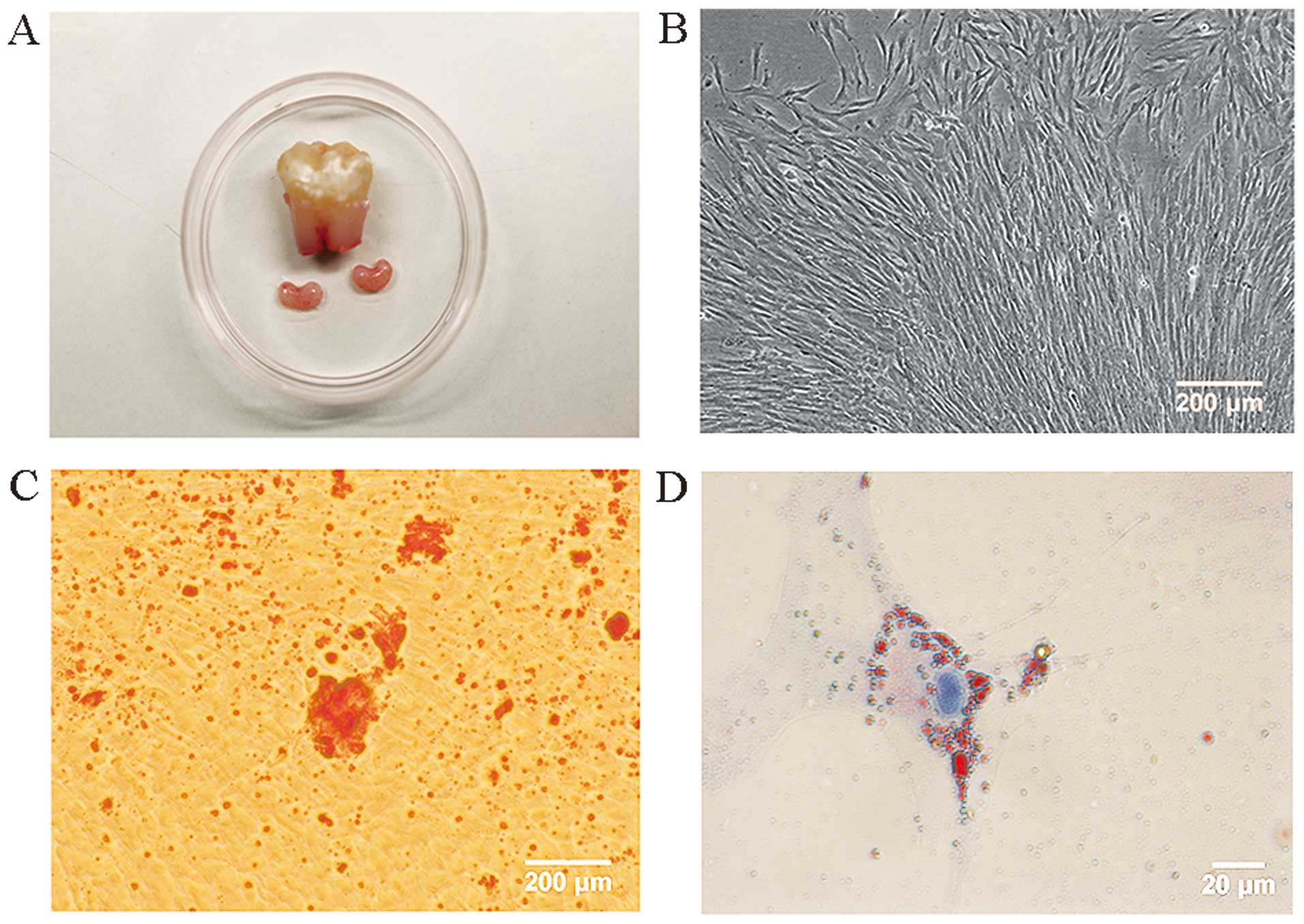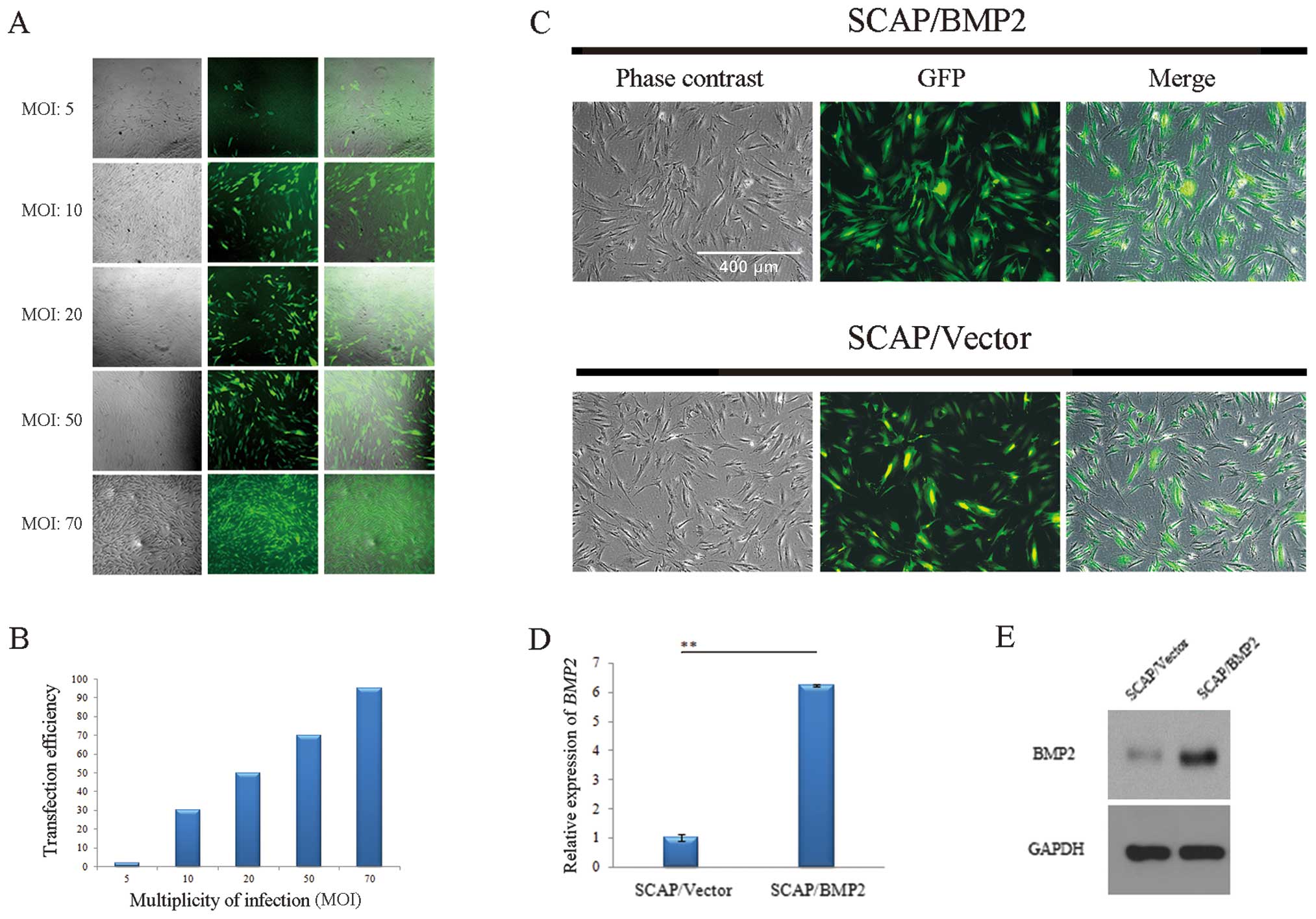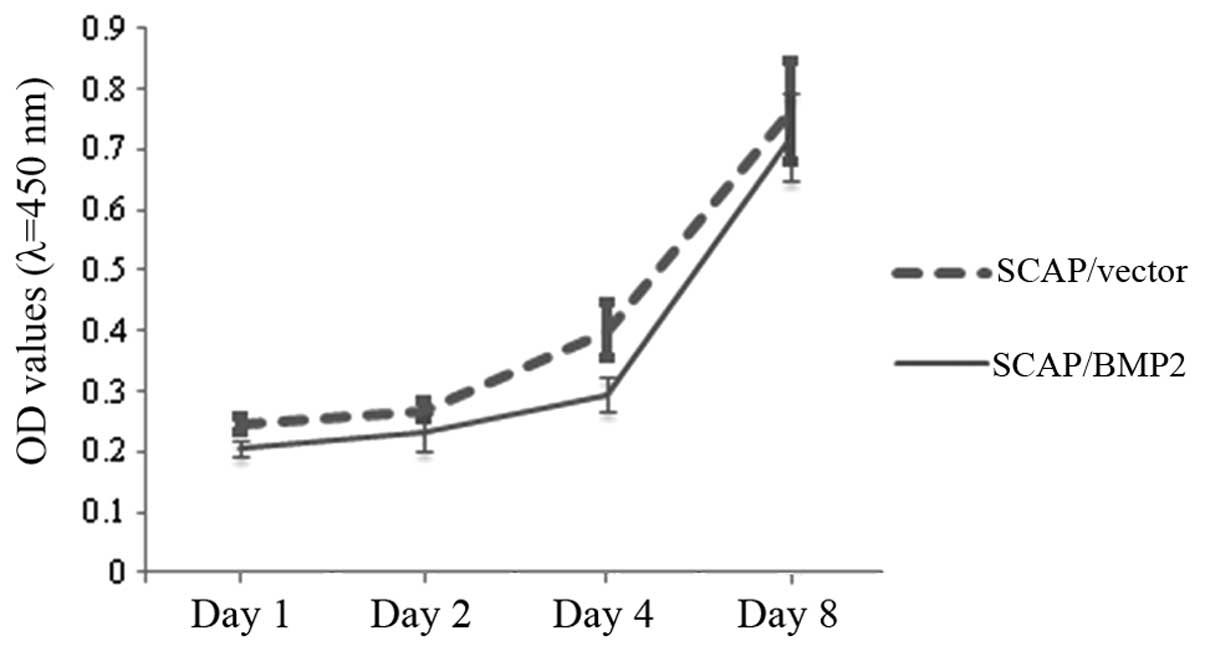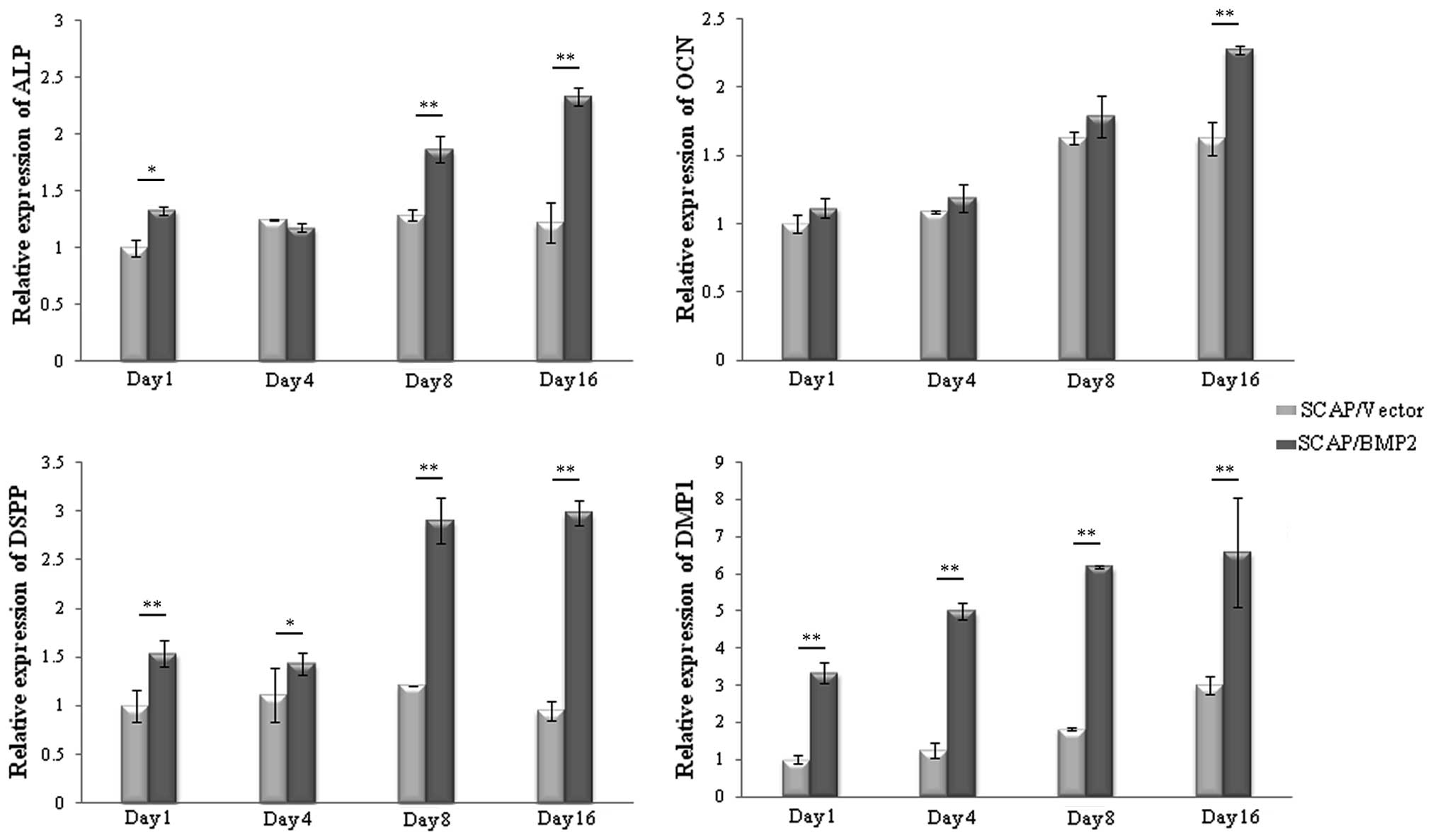|
1
|
Sonoyama W, Liu Y, Fang D, et al:
Mesenchymal stem cell-mediated functional tooth regeneration in
swine. PLoS One. 1:e792006. View Article : Google Scholar : PubMed/NCBI
|
|
2
|
Wu J, Huang GT, He W, et al: Basic
fibroblast growth factor enhances stemness of human stem cells from
the apical papilla. J Endod. 38:614–622. 2012. View Article : Google Scholar : PubMed/NCBI
|
|
3
|
Bakopoulou A, Leyhausen G, Volk J, et al:
Comparative analysis of in vitro osteo/odontogenic differentiation
potential of human dental pulp stem cells (DPSCs) and stem cells
from the apical papilla (SCAP). Arch Oral Biol. 56:709–721. 2011.
View Article : Google Scholar
|
|
4
|
Bakopoulou A, Leyhausen G, Volk J, Koidis
P and Geurtsen W: Comparative characterization of (neg)/CD146(pos)
and STRO-1 (neg)/CD146(pos) apical papilla stem cells enriched with
flow cytometry. Arch Oral Biol. 58:1556–1568. 2013. View Article : Google Scholar : PubMed/NCBI
|
|
5
|
Sonoyama W, Liu Y, Yamaza T, et al:
Characterization of the apical papilla and its residing stem cells
from human immature permanent teeth: a pilot study. J Endod.
34:166–171. 2008. View Article : Google Scholar : PubMed/NCBI
|
|
6
|
Huang GT, Sonoyama W, Liu Y, Liu H, Wang S
and Shi S: The hidden treasure in apical papilla: the potential
role in pulp/dentin regeneration and bioroot engineering. J Endod.
34:645–651. 2008. View Article : Google Scholar : PubMed/NCBI
|
|
7
|
Huang GT, Gronthos S and Shi S:
Mesenchymal stem cells derived from dental tissues vs. those from
other sources: their biology and role in regenerative medicine. J
Dent Res. 88:792–806. 2009.PubMed/NCBI
|
|
8
|
Yang W, Harris MA, Cui Y, Mishina Y,
Harris SE and Gluhak-Heinrich J: Bmp2 is required for odontoblast
differentiation and pulp vasculogenesis. J Dent Res. 91:58–64.
2012. View Article : Google Scholar : PubMed/NCBI
|
|
9
|
Wang Y, Li L, Zheng Y, et al: BMP activity
is required for tooth development from the lamina to bud stage. J
Dent Res. 91:690–695. 2012. View Article : Google Scholar : PubMed/NCBI
|
|
10
|
Rakian A, Yang WC, Gluhak-Heinrich J, et
al: Bone morphogenetic protein-2 gene controls tooth root
development in coordination with formation of the periodontium. Int
J Oral Sci. 5:75–84. 2013. View Article : Google Scholar : PubMed/NCBI
|
|
11
|
Saito T, Ogawa M, Hata Y and Bessho K:
Acceleration effect of human recombinant bone morphogenetic
protein-2 on differentiation of human pulp cells into odontoblasts.
J Endod. 30:205–208. 2004. View Article : Google Scholar : PubMed/NCBI
|
|
12
|
Iohara K, Nakashima M, Ito M, Ishikawa M,
Nakasima A and Akamine A: Dentin regeneration by dental pulp stem
cell therapy with recombinant human bone morphogenetic protein 2. J
Dent Res. 83:590–595. 2004. View Article : Google Scholar : PubMed/NCBI
|
|
13
|
Yang X, van der Kraan PM, van den Dolder
J, et al: STRO-1 selected rat dental pulp stem cells transfected
with adenoviral-mediated human bone morphogenetic protein 2 gene
show enhanced odontogenic differentiation. Tissue Eng.
13:2803–2812. 2007. View Article : Google Scholar
|
|
14
|
Yang X, Walboomers XF, van den Dolder J,
et al: Non-viral bone morphogenetic protein 2 transfection of rat
dental pulp stem cells using calcium phosphate nanoparticles as
carriers. Tissue Eng Part A. 14:71–81. 2008. View Article : Google Scholar : PubMed/NCBI
|
|
15
|
Yang X, van der Kraan PM, Bian Z, Fan M,
Walboomers XF and Jansen JA: Mineralized tissue formation by
BMP2-transfected pulp stem cells. J Dent Res. 88:1020–1025. 2009.
View Article : Google Scholar : PubMed/NCBI
|
|
16
|
Yang X, Walboomers XF, van den Beucken JJ,
Bian Z, Fan M and Jansen JA: Hard tissue formation of
STRO-1-selected rat dental pulp stem cells in vivo. Tissue Eng Part
A. 15:367–375. 2009. View Article : Google Scholar : PubMed/NCBI
|
|
17
|
Lahmy R, Soleimani M, Sanati MH, Behmanesh
M, Kouhkan F and Mobarra N: Pancreatic islet differentiation of
human embryonic stem cells by microRNA overexpression. J Tissue Eng
Regen Med. 30: View Article : Google Scholar : 2013.PubMed/NCBI
|
|
18
|
Hwang SY, Foley J, Numaga-Tomita T,
Petranka JG, Bird GS and Putney JW Jr: Deletion of Orai1 alters
expression of multiple genes during osteoclast and osteoblast
maturation. Cell Calcium. 52:488–500. 2012. View Article : Google Scholar : PubMed/NCBI
|
|
19
|
Wei X, Wu L, Ling J, et al: Differentially
expressed protein profile of human dental pulp cells in the early
process of odontoblast-like differentiation in vitro. J Endod.
34:1077–1084. 2008. View Article : Google Scholar : PubMed/NCBI
|
|
20
|
Langenbach F and Handschel J: Effects of
dexamethasone, ascorbic acid and β-glycerophosphate on the
osteogenic differentiation of stem cells in vitro. Stem Cell Res
Ther. 4:1172013.
|
|
21
|
Hitomi K, Torii Y and Tsukagoshi N:
Increase in the activity of alkaline phosphatase by L-ascorbic acid
2-phosphate in a human osteoblast cell line, HuO-3N1. J Nutr Sci
Vitaminol (Tokyo). 38:535–544. 1992. View Article : Google Scholar : PubMed/NCBI
|
|
22
|
Shima N, Kimoto M, Yamaguchi M and
Yamagami S: Increased proliferation and replicative lifespan of
isolated human corneal endothelial cells with L-ascorbic acid
2-phosphate. Invest Ophthalmol Vis Sci. 52:8711–8717. 2011.
View Article : Google Scholar : PubMed/NCBI
|
|
23
|
Choi KS, Ahn SY, Kim TS, et al:
Characterization and biodistribution of human mesenchymal stem
cells transduced with lentiviral-mediated BMP2. Arch Pharm Res.
34:599–606. 2011. View Article : Google Scholar : PubMed/NCBI
|
|
24
|
Kutner RH, Zhang XY and Reiser J:
Production, concentration and titration of pseudotyped HIV-1-based
lentiviral vectors. Nat Protoc. 4:495–505. 2009. View Article : Google Scholar : PubMed/NCBI
|
|
25
|
Reiser J: Production and concentration of
pseudotyped HIV-1-based gene transfer vectors. Gene Ther.
7:910–913. 2000. View Article : Google Scholar : PubMed/NCBI
|
|
26
|
Li R, Peng L, Ren L, Tan H and Ye L:
Hepatocyte growth factor exerts promoting functions on murine
dental papilla cells. J Endod. 35:382–388. 2009. View Article : Google Scholar : PubMed/NCBI
|
|
27
|
Choi MH, Noh WC, Park JW, Lee JM and Suh
JY: Gene expression pattern during osteogenic differentiation of
human periodontal ligament cells in vitro. J Periodontal Implant
Sci. 41:167–175. 2011. View Article : Google Scholar : PubMed/NCBI
|
|
28
|
Yu J, Deng Z, Shi J, et al:
Differentiation of dental pulp stem cells into regular-shaped
dentin-pulp complex induced by tooth germ cell conditioned medium.
Tissue Eng. 12:3097–3105. 2006. View Article : Google Scholar : PubMed/NCBI
|
|
29
|
Wang C, Ren L, Peng L, Xu P, Dong G and Ye
L: Effect of Wnt6 on human dental papilla cells in vitro. J Endod.
36:238–243. 2010. View Article : Google Scholar : PubMed/NCBI
|
|
30
|
Chen K, Xiong H, Huang Y and Liu C:
Comparative analysis of in vitro periodontal characteristics of
stem cells from apical papilla (SCAP) and periodontal ligament stem
cells (PDLSCs). Arch Oral Biol. 58:997–1006. 2013. View Article : Google Scholar : PubMed/NCBI
|
|
31
|
Yue J, Wu B, Gao J, et al: DMP1 is a
target of let-7 in dental pulp cells. Int J Mol Med. 30:295–301.
2012.PubMed/NCBI
|
|
32
|
Feng JQ, Huang H, Lu Y, et al: The Dentin
matrix protein 1 (Dmp1) is specifically expressed in mineralized,
but not soft, tissues during development. J Dent Res. 82:776–780.
2003. View Article : Google Scholar : PubMed/NCBI
|
















